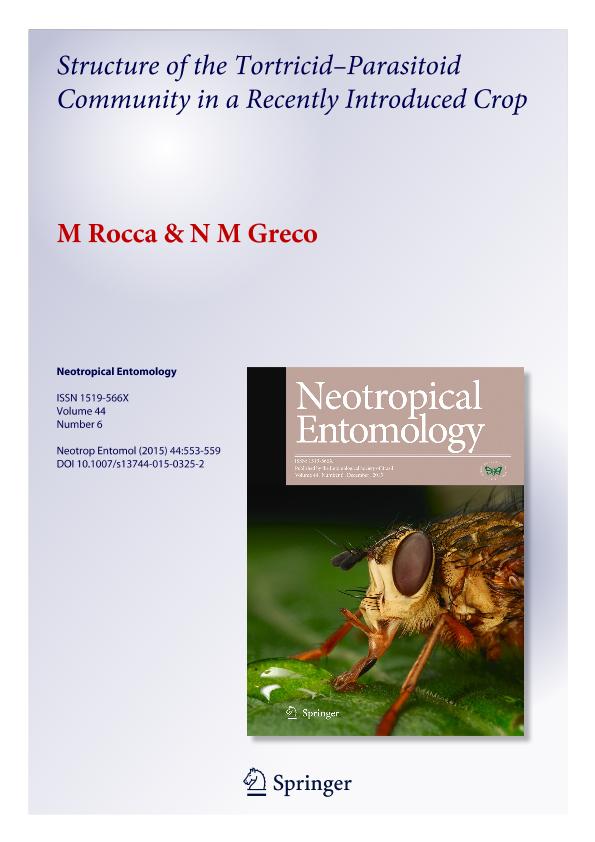Mostrar el registro sencillo del ítem
dc.contributor.author
Rocca, Margarita

dc.contributor.author
Greco, Nancy Mabel
dc.date.available
2016-12-16T14:01:30Z
dc.date.issued
2015-09
dc.identifier.citation
Rocca, Margarita; Greco, Nancy Mabel; Structure of the Tortricid-Parasitoid community in a recently introduced blueberry crop.; Sociedade Entomológica Do Brasil; Neotropical Entomology; 44; 6; 9-2015; 553-559
dc.identifier.issn
1519-566X
dc.identifier.uri
http://hdl.handle.net/11336/9565
dc.description.abstract
The introduction of exotic commercial plants represents a change in the food resources for the communities of herbivores. The blueberry is native to the northern hemisphere and was recently introduced in Argentina, so we expect to find polyphagous tortricids and a low complexity in the tortricid–parasitoid community. Tortricids are exophytic leaf-rollers and flower and fruit feeders, they can feed on different plant structures, and they may be present in every blueberry phenological stage. The aims of this study were (a) to estimate the relative abundance of tortricids in different plant structures and phenological stages of blueberry, (b) to evaluate the relative importance of the different parasitoid guilds, and (c) to describe the tortricid–parasitoid community in blueberry fields of Argentina. The abundance of tortricids in blueberries was low and mainly localized to flowers and fruits. Five parasitoid guilds were identified: early larval endoparasitoids (Apanteles sp. and Dolichogenidea m1 and m2), larval–prepupal endoparasitoids (Austroearinus sp.), larval–pupal endoparasitoids (Ichneumonidae), larval ectoparasitoids (Eulophidae), and pupal endoparasitoids (Brachymeria sp. and Conura sp.). Most parasitoids were koinobiont larval endoparasitoids. The tortricid–parasitoid food web was very simple in comparison to those of other systems, with high values of vulnerability and connectance. The results of this study suggest that the abundance of tortricids in blueberry crop in Argentina is low. From the point of view of production, the risk of economic losses and the likelihood of direct damage to the fruit would be very low.
dc.format
application/pdf
dc.language.iso
eng
dc.publisher
Sociedade Entomológica Do Brasil

dc.rights
info:eu-repo/semantics/openAccess
dc.rights.uri
https://creativecommons.org/licenses/by-nc-sa/2.5/ar/
dc.subject
Argyrotaenia Sphaleropa
dc.subject
Blueberry
dc.subject
Food Web
dc.subject
Parasitoid Guilds
dc.subject
Vaccinium Corymbosum
dc.subject.classification
Ecología

dc.subject.classification
Ciencias Biológicas

dc.subject.classification
CIENCIAS NATURALES Y EXACTAS

dc.title
Structure of the Tortricid-Parasitoid community in a recently introduced blueberry crop.
dc.type
info:eu-repo/semantics/article
dc.type
info:ar-repo/semantics/artículo
dc.type
info:eu-repo/semantics/publishedVersion
dc.date.updated
2016-12-12T14:33:10Z
dc.identifier.eissn
1678-8052
dc.journal.volume
44
dc.journal.number
6
dc.journal.pagination
553-559
dc.journal.pais
Brasil

dc.description.fil
Fil: Rocca, Margarita. Consejo Nacional de Investigaciones Científicas y Técnicas. Centro Científico Tecnológico la Plata. Centro de Estudios Parasitológicos y de Vectores (i); Argentina. Universidad Nacional de La Plata. Facultad de Ciencias Naturales y Museo; Argentina
dc.description.fil
Fil: Greco, Nancy Mabel. Consejo Nacional de Investigaciones Científicas y Técnicas. Centro Científico Tecnológico la Plata. Centro de Estudios Parasitológicos y de Vectores (i); Argentina. Universidad Nacional de La Plata. Facultad de Ciencias Naturales y Museo; Argentina
dc.journal.title
Neotropical Entomology

dc.relation.alternativeid
info:eu-repo/semantics/altIdentifier/doi/http://dx.doi.org/10.1007/s13744-015-0325-2
Archivos asociados
